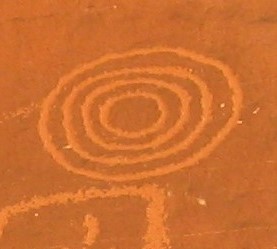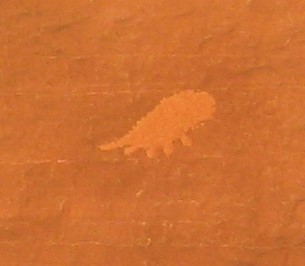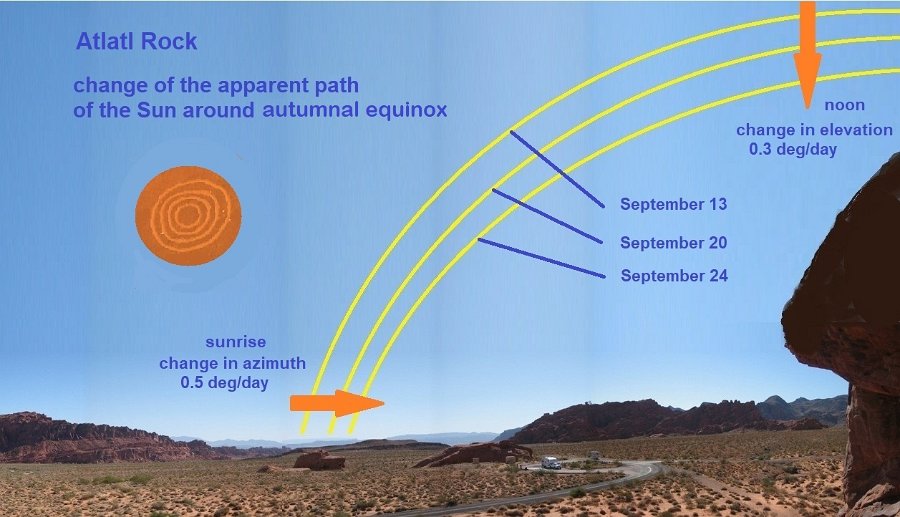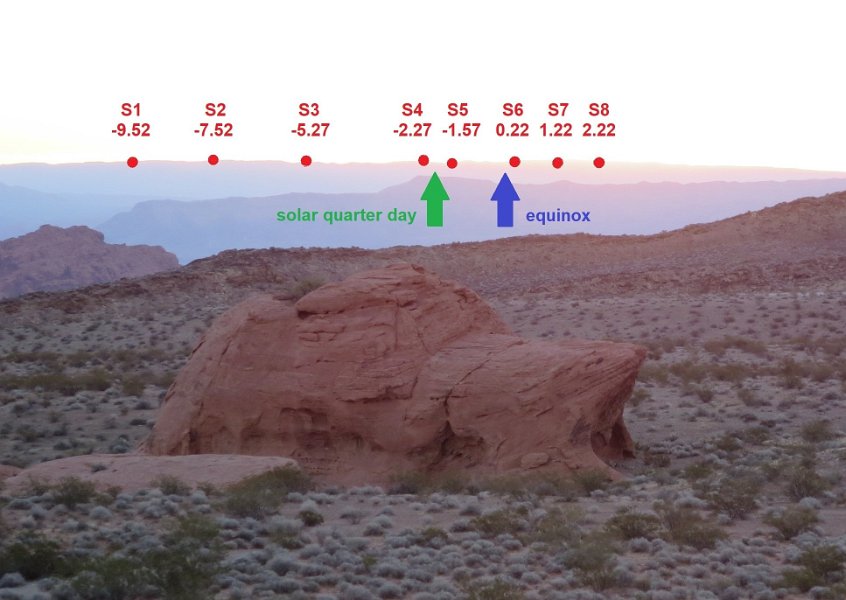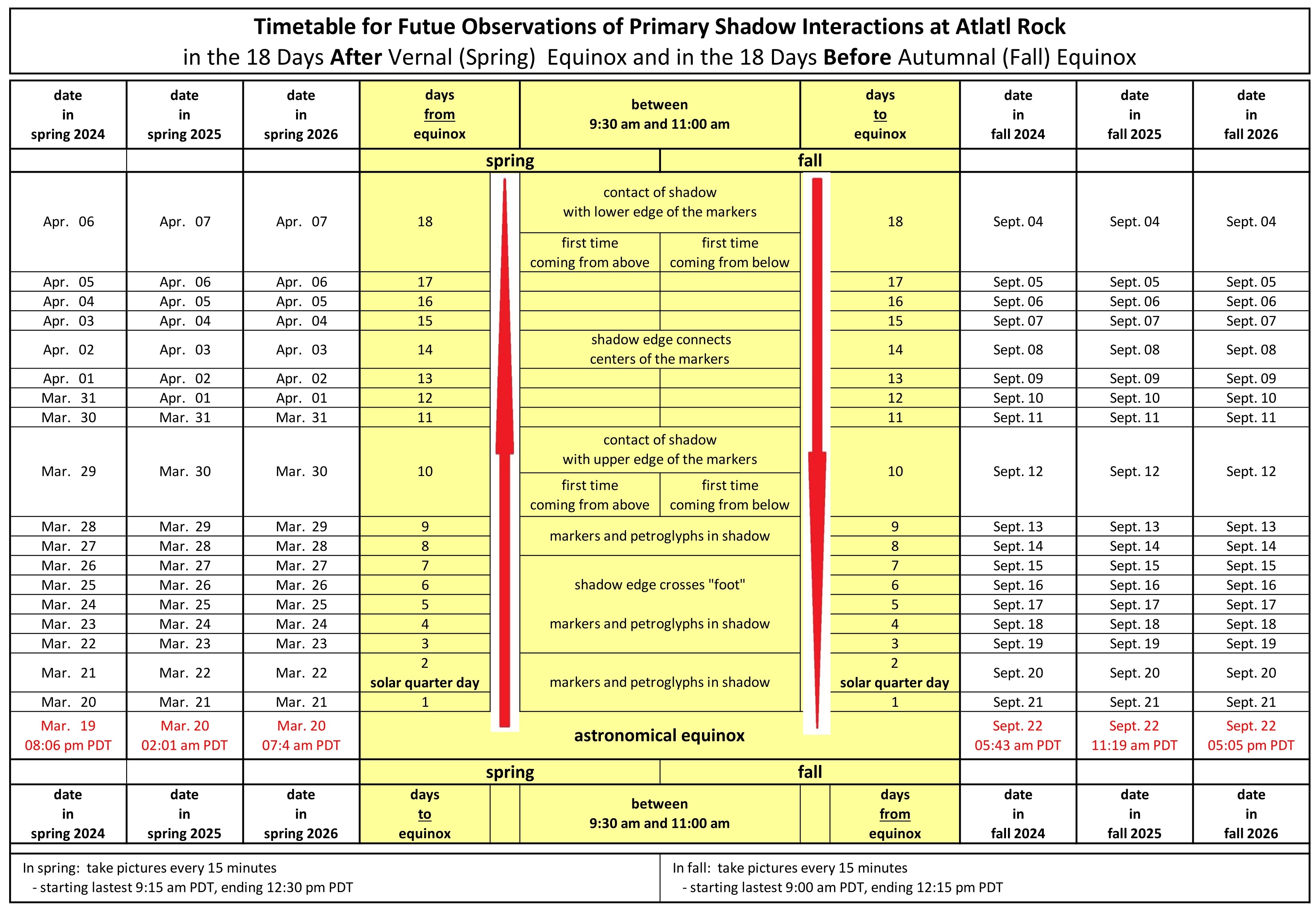 |
ArchaeoastronomyEquinox Observations at Atlatl RockValley of Fire State Park, NV, USA |
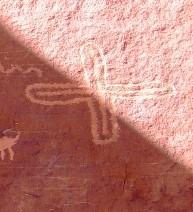 |
Summary of the Observations Around Autumnal Equinox
A slightly modified summary has been published as a printable pdf file (~4 MB, in letter format) and can be
downloaded here.
|
|||
Location and Description of the Site
|
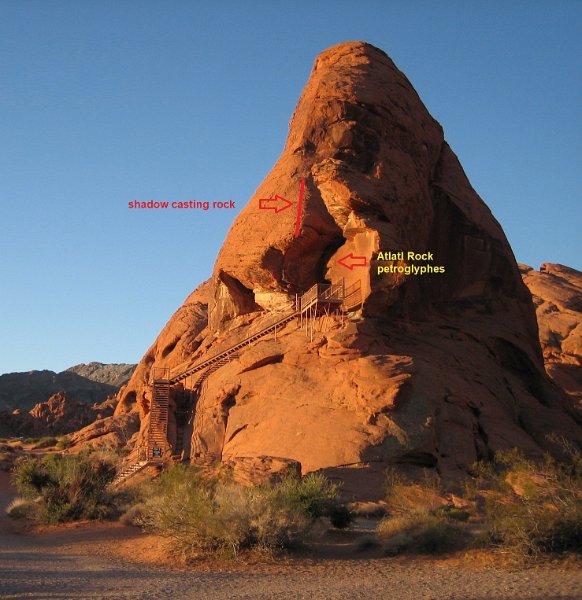 view from NNE (parking lot) about one hour after sunrise in September |
||
|
|
|||
The Markers
|
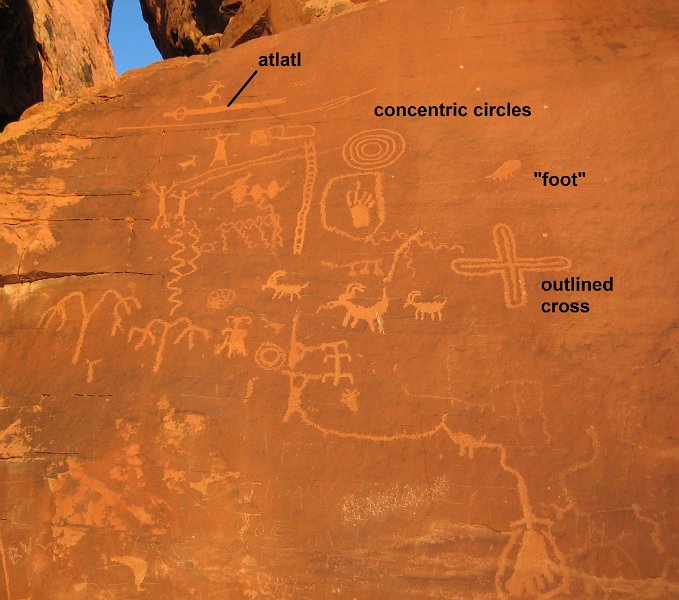 petroglyps in full sunlight after sunrise (in summer - for better visibility) |
||
No clear association of the cross with equal bars like the one at Atlatl Rock as a sign for equinox is found in the literature although it seems obvious to me that this is the case especially here at Atlatl Rock. An outlined cross is mentioned in Patterson 1992: pp. 76 ff, [B05]) but its meaning in the American Southwest is less certain. A search in the literature for rock art symbols similar to the "foot" revealed no clear identification. There is one picture in Patterson (1992: p. 3, [B05], left picture of footprints) that shows footprints which have a slight similarity to the "foot" but no further information on the purpose/function of this "marker" is available. In 2008 we visited the The markers and the interaction with the shadow that indicates certain dates around the equinoxes can be viewed easily from any position in front of the rock. They do not require a special position of the observer and thus can be viewed by many people at the same time. This is contrary to markers in the landscape or at the horizon that always require the observer to view them from a specific spot. |
|||
The Sun Around Autumnal EquinoxObserving the shadow change around theBut probably equal important is the change to the fall/winter season which may be the time for harvest celebrations and ceremonies. This is described in detail in the literature at many places. Around the equinoxes, the daily sunrise point of the Sun shows the most significant changes on the horizon during a year.
(I am pretty sure that investigations of the area now under the platform, where old steps cut into the rock are visible, will reveal a special point (perhaps marked like the one mentioned in Zoll (2014:14-15; references therein, [B08]) from which the sunrise position on the horizon is to be viewed using alignment "tools" in the foreground like the rocks.) |
|||
Shadow at Atlatl RockThere are two reasons that cause the movement of the shadow edge across the Atlatl Rock wall during the year and during a day:- the primary shadow movement is caused by the change in elevation of the Sun between following days - the secondary shadow movement is caused the changing azimuth and elevation of the Sun during one day (part 1) and the effect of the change of the slope of the shadow casting rock in the ~ 1.5 hours before noon (part 2). Primary Shadow Movement : The rock south of the Atlatl Rock wall that casts the shadow onto the wall where the petroglyphs with the atlatl are has an almost straight upper edge which casts a shadow with an straight upper edge onto the wall. The decreasing elevation of the Sun after the summer solstice causes the upper shadow edge at Atlatl Rock to move upward between each following day. In the first couple of weeks after solstice, the change in elevation is small. Around equinox, however the change in shadow position has a maximum of about 0.36 deg each day and this causes the upper shadow edge around the autumnal equinox to move upward significantly between following days. This is shown in a movie that shows the shadow position for each of the nine days before astronomical autumnal equinox at the same time at ~ 10:45 am PDT. In the time span between 9:30 am PDT and 10:50 am PDT each day the shadow edge is very straight and almost constant in position and thus 10:45 am PDT is a good reference point in time for the description of the behavior of the shadow edge before the downward movement of the shadow starts. Secondary Shadow Movement: (the downward movement of the shadow edge after 10:50 am PDT) A detailed definition, description and the reason for final conclusion about the secondary shadow movement is available on the "analysis" page! All the detailed observations of the secondary shadow movement lead to the conclusion, that the interplay of the shadow edge and the markers is too vague and too uncertain to establish a clear signature. It therefore has been decided to only consider the primary shadow movement to have a clear connection to the solar quarter days and the equinoxes. | |||
What is Marked?During the 12 years since my chance discovery of the alignment of the shadow at Atlatl Rock with the concentric circles and the cross and its connection to the equinoxes, my ideas about the meaning of the timing and the markers have changed a lot.The first idea was that at the date of the equinox, the shadow line would connect the centers of the concentric rings and the cross. This turned out not to be the case as this happens about 12 days before autumnal equinox (and 12 days after vernal equinox). The next idea was that the last day during the secondary shadow movement, on which it was possible to observe the shadow to cross the centers of the markers, is the equinox. However, this turned out to be not very well defined and also far off the date of the equinox. Finally, it turned out that the interaction of the shadow line with the "foot" during the primary shadow movement is the closest event to the equinox. It is even coincident with the solar quarter day! It seems that the time in spring, when the vernal equinox (or vernal solar quarter day) has been reached, a couple of days (12) later, the crossing of the shadow line across the circles and the cross, bisecting them, may have had a special meaning and may have marked a certain date. As in other cultures, it may have been the date to start planting. The offset of almost half a month from the equinox/solar quarter day may be due to the geographical location of the site and the climatic circumstances. There is no doubt, that the shadow at Atlatl Rock and its interplay with the markers has some connection to the equinoxes, but the purpose of the various other alignments remain unexplained so far and are open to educated guesses. |
|||
The Resulting General Picture Over the YearAs explained above, only the primary shadow movement is considered to be of importance as the secondary shadow movement does not provide a clear signature to determine any date.From the description of the observations in 2017 and 2018 during the nine days before and one day after autumnal equinox the following general picture over the year (starting in summer) can be derived. Note for the following description:
Summer / FallDuring "summer", i.e. the time between vernal equinox and autumnal equinox, the upper shadow edge cast by the rock south of the Atlatl Rock wall is always below the markers that are proposed to indicate the dates near the equinoxes. Most of the petroglyphs are always in sunlight until the wall is in self shadow each day. Starting already soon after summer solstice, the decreasing elevation of the Sun causes the shadow line to move upward between each following day and more and more petroglyphs are in the shadow zone.Around the autumnal equinox the interaction of the shadow line and the markers is as follows (equinox at September 22 assumed): About 18 days prior to the equinox (~Sept. 4th), the shadow line approaching the markers closer each day from below touches for the first time the lower part of the concentric circles and the cross. Between the following days it continues to move upward. Around 14 days prior to the equinox (~Sept. 8th), the shadow edge connects the centers of the markers. The upward movement of the shadow line on each following day continues until about 10 days prior to the equinox (~Sept. 12th), when the shadow line touches the circles and the cross during the primary shadow movement for the last time. The only marker then left in sun light above the shadow line is the "foot"! The shdow line continues to move upward and reaches the "foot" three days later (about 7 days before the equinox) (~Sept. 15th). In the following days it crosses the foot until two days before equinox (~Sept. 20th), when also the "foot" is completely in the shadow zone below the shadow line. Two days before autumnal equinox is the autumnal solar quarter day! Winter / SpringDuring "winter", i.e. the time between the autumnal equinox and the vernal equinox, the petroglyphs stay in shadow all the time once the shadow tip has reached them shortly after sunrise. This holds until the middle of March (~ March 20th), when the shadow line approaches the markers from above and the observations of the movement of the shadow line before autumnal equinox happen in reverse order (equinox at March 20 assumed):- the "foot" is touched the first time (~ March 23rd) - shadow line below "foot", but above circles and cross (~ March 28th) - shadow line at upper edge of circles and cross (~ March 30th) - shadow line connects center of circles and cross (~ April 3rd) - shadow line at lower edge of circles and cross (~ April 7th) - more and more Atlatl Rock petroglyphs are always in sunlight Note: Due to the equation of time, local noon and all derived times are different in March and September so that times in March are later by almost 10 minutes (see here) as compared to the observed times in September. Timetable for Future Observations |
|||
Remarks, Open Questions, Thoughts, and Proposed Observations
|
|||
by Helmut Steinle
